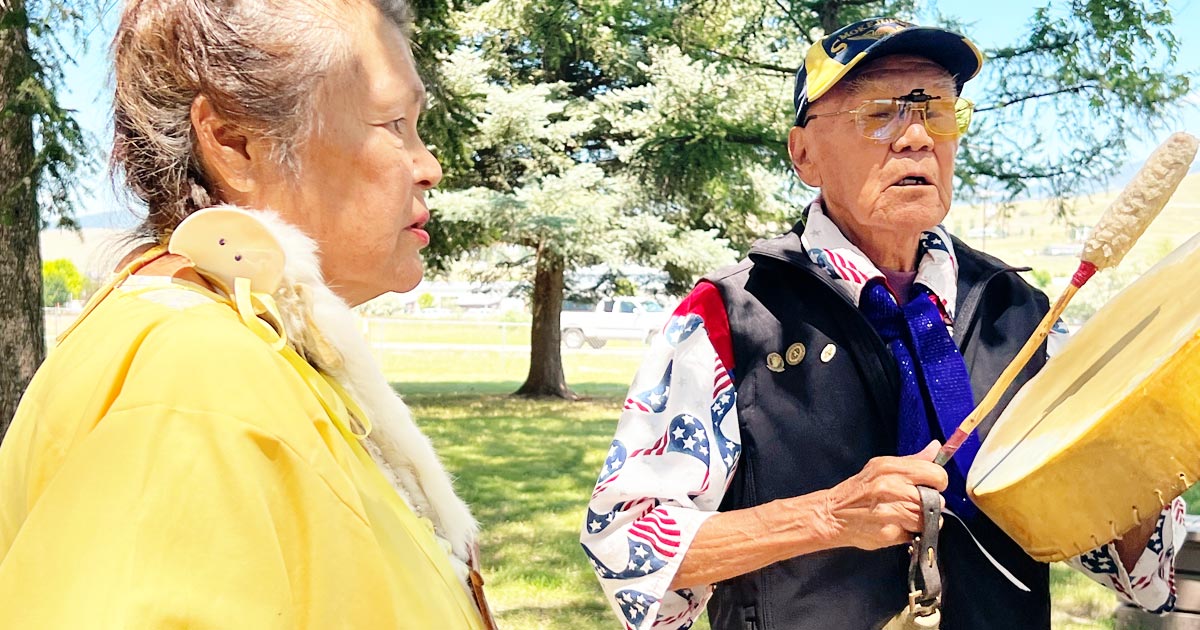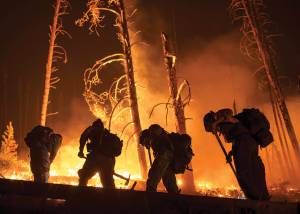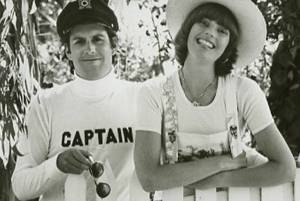By NANN PARRETT
Wearing his McCall, Idaho smokejumper vest over a white, American-flag print shirt and his head topped with his smokejumper cap, Dr. Ron Pond, 82, pulled out a hide-frame hand drum and padded drumstick from the case he was toting.
He teetered as my daughter, who had joined me for this trip to Missoula, Montana, held his elbow while they stood before the National Smokejumper Memorial at the Smokejumper Visitor Center.
“We are here to honor loved ones who sacrificed their lives. They were there to protect the resources of our Mother Earth,” said Ron, a registered member of the Umatilla tribe in eastern Oregon. “That’s why we’re here. To pay homage.”
Once steadied, Ron rang a bell clenched in his fist, then beat the drum numerous times, the bell tinkling with each hit. He performed this cycle three times to summon the spirits before performing a blessing honoring the 12 smokejumpers and local fire guard who perished August 5, 1949 in the Mann Gulch fire that whirled out of control when high winds blasted through the Gates of the Mountains Wilderness area outside of Helena, Montana.
His daughter, Lona Pond, stood beside him, dressed in a traditional yellow robe and white moccasins. She joined her father to sing a song, called “Kotts’ii’yow’yah,” which translates into English as, “Thank You.”
“It’s a Nez Perce song thanking the creator for sharing a person with us on Earth,” said Lona. “Today we’re thanking the creator for all the firefighters who died so young.”
Lona announced each name, and Ron then beat the drum once after each one: Robert J. Bennet, 19 (Paris, Tenn.); Eldon E. Diettert, 19 (Moscow, Idaho); James O. Harrison, 20 (Missoula, Mont.); William J. Hellman, 24 (Kalispell, Mont.); Philip R. McVey, 22 (Babb, Mont.); David R. Navon, 28 (Modesto, Calif.); Leonard L. Piper, 23 (Blairsville, Penn.); Stanley J. Reba, (Brookly, NY); Marvin L. Sherman, 21 (Missoula, Mont.); Joseph B. Sylvia, 24 (Plymouth, Mass.); Henry J. Thol Jr., 19 (Kalispell, Mont.), Newton R. Thompson, 23 (Alhambra, Calif.); and Silas R. Thompson, 21 (Charlotte, NC).
“They perished, but they are not forgotten,” said Ron. “We have one important word in our language: Nuu’miip’nii’shix. It means “we remember.”
The pair traveled over from their home in Pendleton, Oregon, to fulfill a promise they’d made about 10 years ago to the last living survivor of the Mann Gulch blaze, Robert Salee.
“My father and I met him at a smokejumper reunion, and he wanted my dad to do a ceremony for him up here,” said Lona. She said their conversation with Salee was especially meaningful when it turned to the smokejumper foreman for the Mann Gulch fire, Wagner Dodge.
Dodge famously survived the blaze, unscathed, by lighting an escape fire to burn the grassland ahead of him—essentially creating an “island of safety” that he subsequently crossed into to protect himself from the towering wall of flames closing in behind. He had been unable to persuade his crew to enter into the escape fire—they opted instead to try to outrun the blaze. Only two of those individuals survived.
According to Lona, Salee told her and her father Dodge had confided that he had gotten the idea for lighting an escape blaze from what he had learned about Native American slash-and-burn societies.
“Our mouths dropped open that this smokejumper was telling us this story about wildland fires,” said Lona.
Lona, like her father, is no stranger to fire. Theirs is a family of hotshots and smokejumpers, elite firefighters specially trained to battle wildfires in rugged, remote areas. Hotshots work on 20-person crews who generally hike on foot to reach backcountry fires. Smokejumpers, on the other hand, work in smaller groups, parachuting into the harder-to-reach places.
Ron’s father, Walter Pond, returned from serving in the Philippines during WWII to work as fire manager for the Bureau of Indian Affairs in the 40s and 50s. Ron followed his father’s footsteps into the flames, serving from 1966 to 1969 as McCall, Idaho’s first Native American smokejumper. Both Lona’s brother and her former husband were also smokejumpers who trained and jumped out of the Missoula base.
Lona served in wildland fires from 1979 to 2001 and worked with the Baker River hotshots in Oregon for 11 of those years. Even though she was invited to join the smokejumper crews in Redding, California, and Fort Wainwright, Alaska, she had to decline because of health problems resulting from injuries on the job.
“I knew I would never become a smokejumper because I got too old, and my body was not strong enough anymore after the injuries,” she said. Ron sustained injuries as well while on the job.
“I got hurt in a fire jump into the middle of Salmon River country,” he said. “I got caught in a high wind.”
He recalled looking behind him and oscillating his parachute forward and backward as he dropped. He flexed and braced himself for a landing, but the wind whipped him up, and he was thrown back, hitting his head and suffering a severe concussion.
“I hit so hard, it took the breath out of me,” he said. “I was paralyzed and couldn’t move. My eyes were open, but I couldn’t see anything.”
His comrades took the pads out of Ron’s suit and tied his legs up. Then a senior smokejumper loaded Ron onto his back and brought him down the hill to an awaiting helicopter that whisked him off to a hospital in Salmon, Idaho, where he remained for a few days.
“I hardly remember getting any medical treatment. No medication. No nothing,” he said. Over time, those injuries have snuck back up on him. Today he suffers from severe arthritis, which he attributes to his firefighting injuries. He struggles to even walk.
“Many young firefighters will never understand this until later in life, but these scars are here to help us remember,” said Lona.
Nuu’miip’nii’shix. ISI









